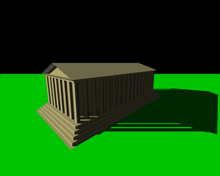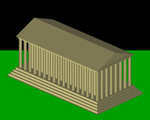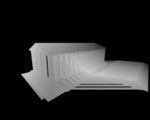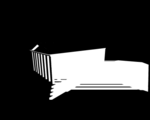119:
189:
381:
111:
28:
457:
20:
246:
matrix multiplication to map those −1 to 1 values to 0 to 1, which are more usual coordinates for depth map (texture map) lookup. This scaling can be done before the perspective division, and is easily folded into the previous transformation calculation by multiplying that matrix with the following:
81:
If you looked out from a source of light, all the objects you can see would appear in light. Anything behind those objects, however, would be in shadow. This is the basic principle used to create a shadow map. The light's view is rendered, storing the depth of every surface it sees (the shadow map).
179:
coordinates with axis X and Y to represent its geometric shape on screen, these vertex coordinates will match up with the corresponding edges of the shadow parts within the shadow map (depth map) itself. The second step is the depth test which compares the object z values against the z values from
525:
or shadow continuity glitches. A simple way to overcome this limitation is to increase the shadow map size, but due to memory, computational or hardware constraints, it is not always possible. Commonly used techniques for real-time shadow mapping have been developed to circumvent this limitation.
153:
In many implementations, it is practical to render only a subset of the objects in the scene to the shadow map to save some of the time it takes to redraw the map. Also, a depth offset which shifts the objects away from the light may be applied to the shadow map rendering in an attempt to resolve
437:
implementation, this test would be done at the fragment level. Also, care needs to be taken when selecting the type of texture map storage to be used by the hardware: if interpolation cannot be done, the shadow will appear to have a sharp, jagged edge (an effect that can be reduced with greater
533:, several solutions have been developed, either by doing several lookups on the shadow map, generating geometry meant to emulate the soft edge or creating non-standard depth shadow maps. Notable examples of these are Percentage Closer Filtering, Smoothies, and Variance Shadow maps.
364:
149:
This depth map must be updated any time there are changes to either the light or the objects in the scene, but can be reused in other situations, such as those where only the viewing camera moves. (If there are multiple lights, a separate depth map must be used for each light.)
89:, but the shadow map can be a faster alternative depending on how much fill time is required for either technique in a particular application and therefore may be more suitable to real-time applications. In addition, shadow maps do not require the use of an additional
158:
problems where the depth map value is close to the depth of a surface being drawn (i.e., the shadow-casting surface) in the next step. Alternatively, culling front faces and only rendering the back of objects to the shadow map is sometimes used for a similar result.
141:
From this rendering, the depth buffer is extracted and saved. Because only the depth information is relevant, it is common to avoid updating the color buffers and disable all lighting and texture calculations for this rendering, to save drawing time. This
101:
Rendering a shadowed scene involves two major drawing steps. The first produces the shadow map itself, and the second applies it to the scene. Depending on the implementation (and the number of lights), this may require two or more drawing passes.
468:
are available, the depth map test may be performed by a fragment shader which simply draws the object in shadow or lighted depending on the result, drawing the scene in a single pass (after an initial earlier pass to generate the shadow map).
252:
489:) this should technically be done using only the ambient component of the light, but this is usually adjusted to also include a dim diffuse light to prevent curved surfaces from appearing flat in shadow.
372:, or other graphics hardware extension, this transformation is usually applied at the vertex level, and the generated value is interpolated between other vertices and passed to the fragment level.
441:
It is possible to modify the depth map test to produce shadows with a soft edge by using a range of values (based on the proximity to the edge of the shadow) rather than simply pass or fail.
196:
To test a point against the depth map, its position in the scene coordinates must be transformed into the equivalent position as seen by the light. This is accomplished by a
54:
in 1978, in a paper entitled "Casting curved shadows on curved surfaces." Since then, it has been used both in pre-rendered and realtime scenes in many console and PC games.
521:
One of the key disadvantages of real-time shadow mapping is that the size and depth of the shadow map determine the quality of the final shadows. This is usually visible as
207:
The matrix used to transform the world coordinates into the light's viewing coordinates is the same as the one used to render the shadow map in the first step (under
1072:
171:
viewpoint, applying the shadow map. This process has three major components. The first step is to find the coordinates of the object as seen from the light, as a
82:
Next, the regular scene is rendered comparing the depth of every point drawn (as if it were being seen by the light, rather than the eye) to this depth map.
499:
to combine their effect with the lights already drawn. (Each of these passes requires an additional previous pass to generate the associated shadow map.)
639:
93:
and can be modified to produce shadows with a soft edge. Unlike shadow volumes, however, the accuracy of a shadow map is limited by its resolution.
1156:
752:
695:
430:) location falls outside the depth map, the programmer must either decide that the surface should be lit or shadowed by default (usually lit).
529:
Also notable is that generated shadows, even if aliasing free, have hard edges, which is not always desirable. In order to emulate real world
931:
564:
359:{\displaystyle {\begin{bmatrix}0.5&0&0&0.5\\0&0.5&0&0.5\\0&0&0.5&0.5\\0&0&0&1\end{bmatrix}}}
492:
Enable the depth map test and render the scene lit. Areas where the depth map test fails will not be overwritten and will remain shadowed.
1353:
905:
832:
1064:
526:
These include
Cascaded Shadow Maps, Trapezoidal Shadow Maps, Light Space Perspective Shadow maps, or Parallel-Split Shadow maps.
478:), which usually does not allow a choice between two lighting models (lit and shadowed), and necessitate more rendering passes:
633:
1742:
1715:
915:
734:
472:
If shaders are not available, performing the depth map test must usually be implemented by some hardware extension (such as
1758:
1362:
130:
as wide as its desired angle of effect (it will be a sort of square spotlight). For directional light (e.g., that from the
51:
448:. The picture above captioned "visualization of the depth map projected onto the scene" is an example of such a process.
1482:
1305:
444:
The shadow mapping technique can also be modified to draw a texture onto the lit regions, simulating the effect of a
819:
1326:
640:
https://developer.nvidia.com/gpugems/gpugems3/part-ii-light-and-shadows/chapter-8-summed-area-variance-shadow-maps
1346:
1216:
1191:
126:
The first step renders the scene from the light's point of view. For a point light source, the view should be a
1605:
1406:
1296:
1262:
1730:
1720:
1610:
1429:
753:
https://web.archive.org/web/20101208212121/http://visual-computing.intel-research.net/art/publications/sdsm/
696:
https://web.archive.org/web/20101208213624/http://visual-computing.intel-research.net/art/publications/avsm/
1725:
1590:
1530:
530:
658:
565:
http://developer.download.nvidia.com/SDK/10.5/opengl/src/cascaded_shadow_maps/doc/cascaded_shadow_maps.pdf
238:) falls between −1 and 1 (if it is visible from the light view). Many implementations (such as OpenGL and
1518:
1339:
180:
the depth map, and finally, once accomplished, the object must be drawn either in shadow or in light.
1316:
841:
performs the shadow test in eye-space rather than light-space to keep texture access more sequential.
201:
1149:
1049:
1007:
965:
890:
627:
558:
1093:
608:
212:
172:
135:
860:
740:
415:) location, the object is considered to be behind an occluding object and should be marked as a
1737:
1687:
1652:
1630:
1625:
808:
485:
168:
127:
758:
508:
1580:
1559:
1503:
1311:
1136:
1036:
994:
952:
877:
197:
1463:
1449:
1393:
722:
634:
http://citeseerx.ist.psu.edu/viewdoc/download?doi=10.1.1.104.2569&rep=rep1&type=pdf
47:
735:
http://citeseerx.ist.psu.edu/viewdoc/download?doi=10.1.1.59.3376&rep=rep1&type=pdf
716:
621:
400:
value corresponds to its associated depth, which can now be tested against the depth map.
211:
this is the product of the modelview and projection matrices). This will produce a set of
8:
1595:
1523:
1411:
746:
204:, but a second set of coordinates must be generated to locate the object in light space.
176:
1122:
764:
1657:
1645:
1492:
1487:
1439:
1268:
670:
473:
464:
Drawing the scene with shadows can be done in several different ways. If programmable
1707:
1600:
1585:
1401:
1258:
911:
710:
689:
589:
496:
664:
1779:
1692:
1682:
1564:
1552:
1250:
419:, to be drawn in shadow by the drawing process. Otherwise, it should be drawn lit.
1272:
577:
1513:
1378:
1370:
1247:
Proceedings of the 2006 symposium on
Interactive 3D graphics and games - SI3D '06
1022:
445:
70:
1321:
1312:
Riemer's step-by-step tutorial implementing Shadow
Mapping with HLSL and DirectX
595:
1118:
813:
90:
1773:
1667:
1541:
1471:
980:
798:
583:
218:
86:
1254:
838:
407:
value is greater than the value stored in the depth map at the appropriate (
1672:
1635:
1620:
1615:
1535:
1476:
1020:
1242:
396:
values usually correspond to a location in the depth map texture, and the
1640:
1508:
1444:
804:
62:
482:
Render the entire scene in shadow. For the most common lighting models (
659:
http://developer.download.nvidia.com/shaderlibrary/docs/shadow_PCSS.pdf
155:
676:
200:. The location of the object on the screen is determined by the usual
143:
1331:
1498:
1116:
904:
Akenine-Mo ̈ller, Tomas; Haines, Eric; Hoffman, Naty (2018-08-06).
522:
239:
1547:
728:
701:
628:
https://doclib.uhasselt.be/dspace/bitstream/1942/8040/1/3227.pdf
559:
https://developer.nvidia.com/gpugems/GPUGems3/gpugems3_ch10.html
495:
An additional pass may be used for each additional light, using
1677:
1434:
1300:
1171:
1097:
938:
504:
465:
434:
369:
208:
43:
609:
https://developer.nvidia.com/gpugems/GPUGems/gpugems_ch11.html
61:
is visible from the light source, by comparing the pixel to a
1697:
1383:
903:
741:
http://www.cspaul.com/doku.php?id=publications:rosen.2012.i3d
118:
58:
1169:
816:, a much slower technique capable of very realistic lighting
645:
27:
1421:
1062:
981:"Anti-aliasing and Continuity with Trapezoidal Shadow Maps"
759:
http://image.diku.dk/projects/media/morten.mikkelsen.07.pdf
188:
380:
69:
image of the light source's view, stored in the form of a
1249:. Association for Computing Machinery. pp. 161–165.
131:
110:
76:
723:
http://www.cs.unc.edu/~zhangh/technotes/shadow/shadow.ps
717:
http://graphics.pixar.com/library/DeepShadows/paper.pdf
622:
https://discovery.ucl.ac.uk/id/eprint/10001/1/10001.pdf
516:
456:
192:
Visualization of the depth map projected onto the scene
19:
1241:
Donnelly, William; Lauritzen, Andrew (14 March 2006).
978:
747:
http://www.idav.ucdavis.edu/func/return_pdf?pub_id=919
261:
1021:
Michael Wimmer; Daniel
Scherzer; Werner Purgathofer.
765:
http://graphics.stanford.edu/papers/silmap/silmap.pdf
255:
513:
to accomplish the shadow map process in two passes.
167:
The second step is to draw the scene from the usual
1327:
Shadow
Mapping implementation using Java and OpenGL
671:
http://www.crcnetbase.com/doi/abs/10.1201/b10648-36
690:http://www.cs.cornell.edu/~kb/publications/ASM.pdf
590:http://www-sop.inria.fr/reves/Marc.Stamminger/psm/
358:
1322:NVIDIA Real-time Shadow Algorithms and Techniques
1240:
1065:"Parallel-Split Shadow Maps on Programmable GPUs"
711:http://sites.google.com/site/osmanbrian2/dpsm.pdf
665:https://jankautz.com/publications/VSSM_PG2010.pdf
146:is often stored as a texture in graphics memory.
16:Method to draw shadows in computer graphic images
1771:
1192:"Common Techniques to Improve Shadow Depth Maps"
822:, another very slow but very realistic technique
388:Once the light-space coordinates are found, the
578:https://www.cg.tuwien.ac.at/research/vr/lispsm/
503:The example pictures in this article used the
1347:
644:SMSR "Shadow Map Silhouette Revectorization"
596:http://bib.irb.hr/datoteka/570987.12_CSSM.pdf
1123:"Rendering Fake Soft Shadows with Smoothies"
833:Smooth Penumbra Transitions with Shadow Maps
782:Light Space Perspective Shadow Maps (LSPSMs)
536:
1306:Shadow Mapping with Today's OpenGL Hardware
861:"Casting curved shadows on curved surfaces"
1354:
1340:
1317:Improvements for Shadow Mapping using GLSL
858:
584:http://www.comp.nus.edu.sg/~tants/tsm.html
460:Final scene, rendered with ambient shadows
183:
105:
1155:CS1 maint: multiple names: authors list (
57:Shadows are created by testing whether a
455:
379:
187:
117:
109:
26:
18:
1772:
77:Principle of a shadow and a shadow map
1361:
1335:
1063:Fan Zhang; Hanqiu Sun; Oskari Nyman.
1023:"Light Space Perspective Shadow Maps"
757:SPPSM "Separating Plane Perspective"
96:
85:This technique is less accurate than
1759:List of computer graphics algorithms
1170:William Donnelly; Andrew Lauritzen.
663:VSSM "Variance Soft Shadow Mapping"
517:Shadow map real-time implementations
451:
162:
122:Scene from the light view, depth map
1420:
907:Real-Time Rendering, Fourth Edition
807:, a slower technique often used in
677:http://getlab.org/publications/FIV/
675:FIV "Fullsphere Irradiance Vector"
13:
826:
607:PCF "Percentage Closer Filtering"
215:that need a perspective division (
114:Scene rendered from the light view
50:. This concept was introduced by
14:
1791:
1290:
669:SSSS "Screen space soft shadows"
576:LiSPSM "Light Space Perspective"
375:
1282:– via ACM Digital Library.
770:
1234:
1209:
1184:
651:
1163:
1110:
1086:
1056:
1014:
979:Tobias Martin; Tiow-Seng Tan.
972:
924:
897:
852:
779:Perspective shadow maps (PSMs)
729:http://gamma.cs.unc.edu/LOGSM/
1:
1716:3D computer graphics software
845:
801:, another shadowing technique
702:http://free-zg.t-com.hr/cssm/
638:SAVSM "Summed Area Variance"
224:normalized device coordinates
1531:Hidden-surface determination
614:
601:
551:
7:
792:
788:Variance Shadow Maps (VSMs)
785:Cascaded Shadow Maps (CSMs)
751:SDSM "Sample Distribution"
694:AVSM "Adaptive Volumetric"
682:
226:, in which each component (
10:
1796:
745:RMSM "Resolution Matched"
570:
1751:
1706:
1573:
1462:
1392:
1369:
1117:Eric Chan, Fredo Durand,
1094:"Shadow Map Antialiasing"
763:SSSM "Shadow Silhouette"
657:PCSS "Percentage Closer"
646:http://bondarev.nl/?p=326
541:
537:Shadow mapping techniques
202:coordinate transformation
23:Scene with shadow mapping
438:shadow map resolution).
242:) require an additional
1743:Vector graphics editors
1738:Raster graphics editors
1297:Hardware Shadow Mapping
1255:10.1145/1111411.1111440
776:Shadow Depth Maps (SDM)
709:DPSM "Dual Paraboloid"
384:Depth map test failures
213:homogeneous coordinates
184:Light space coordinates
136:orthographic projection
106:Creating the shadow map
1626:Checkerboard rendering
1243:"Variance shadow maps"
1217:"Cascaded Shadow Maps"
1172:"Variance Shadow Maps"
1144:Cite journal requires
1044:Cite journal requires
1002:Cite journal requires
960:Cite journal requires
932:"Cascaded shadow maps"
885:Cite journal requires
839:Forward shadow mapping
733:MDSM "Multiple Depth"
557:PSSM "Parallel Split"
486:Phong reflection model
461:
385:
360:
193:
128:perspective projection
123:
115:
42:is a process by which
32:
24:
1581:Affine transformation
1560:Surface triangulation
1504:Anisotropic filtering
510:GL_ARB_shadow_ambient
459:
383:
361:
198:matrix multiplication
191:
121:
113:
31:Scene with no shadows
30:
22:
706:DASM "Deep Adaptive"
700:CSSM "Camera Space"
594:CSSM "Camera Space"
253:
48:3D computer graphics
40:shadowing projection
1596:Collision detection
1524:Global illumination
1075:on January 17, 2010
727:LPSM "Logarithmic"
1646:Scanline rendering
1440:Parallax scrolling
1430:Isometric graphics
1221:Msdn.microsoft.com
1196:Msdn.microsoft.com
739:RTW "Rectilinear"
626:CSM "Convolution"
620:ESM "Exponential"
588:PSM "Perspective"
462:
386:
356:
350:
194:
124:
116:
97:Algorithm overview
33:
25:
1767:
1766:
1708:Graphics software
1601:Planar projection
1586:Back-face culling
1458:
1457:
1402:Alpha compositing
1363:Computer graphics
917:978-1-351-81615-1
835:Willem H. de Boer
497:additive blending
452:Drawing the scene
175:object only uses
163:Shading the scene
1787:
1693:Volume rendering
1565:Wire-frame model
1418:
1417:
1356:
1349:
1342:
1333:
1332:
1284:
1283:
1281:
1279:
1238:
1232:
1231:
1229:
1227:
1213:
1207:
1206:
1204:
1202:
1188:
1182:
1181:
1179:
1178:
1167:
1161:
1160:
1153:
1147:
1142:
1140:
1132:
1130:
1129:
1114:
1108:
1107:
1105:
1104:
1090:
1084:
1083:
1081:
1080:
1071:. Archived from
1060:
1054:
1053:
1047:
1042:
1040:
1032:
1030:
1029:
1018:
1012:
1011:
1005:
1000:
998:
990:
988:
987:
976:
970:
969:
963:
958:
956:
948:
946:
945:
936:
928:
922:
921:
901:
895:
894:
888:
883:
881:
873:
871:
870:
865:
859:Lance Williams.
856:
582:TSM "Trapezoid"
365:
363:
362:
357:
355:
354:
138:should be used.
1795:
1794:
1790:
1789:
1788:
1786:
1785:
1784:
1770:
1769:
1768:
1763:
1747:
1702:
1569:
1514:Fluid animation
1454:
1416:
1388:
1379:Diffusion curve
1371:Vector graphics
1365:
1360:
1293:
1288:
1287:
1277:
1275:
1265:
1239:
1235:
1225:
1223:
1215:
1214:
1210:
1200:
1198:
1190:
1189:
1185:
1176:
1174:
1168:
1164:
1154:
1145:
1143:
1134:
1133:
1127:
1125:
1115:
1111:
1102:
1100:
1092:
1091:
1087:
1078:
1076:
1061:
1057:
1045:
1043:
1034:
1033:
1027:
1025:
1019:
1015:
1003:
1001:
992:
991:
985:
983:
977:
973:
961:
959:
950:
949:
943:
941:
934:
930:
929:
925:
918:
902:
898:
886:
884:
875:
874:
868:
866:
863:
857:
853:
848:
829:
827:Further reading
795:
773:
688:ASM "Adaptive"
685:
654:
632:VSM "Variance"
617:
604:
573:
563:CSM "Cascaded"
554:
544:
539:
519:
454:
378:
368:If done with a
349:
348:
343:
338:
333:
327:
326:
321:
316:
311:
305:
304:
299:
294:
289:
283:
282:
277:
272:
267:
257:
256:
254:
251:
250:
186:
165:
108:
99:
79:
17:
12:
11:
5:
1793:
1783:
1782:
1765:
1764:
1762:
1761:
1755:
1753:
1749:
1748:
1746:
1745:
1740:
1735:
1734:
1733:
1728:
1723:
1712:
1710:
1704:
1703:
1701:
1700:
1695:
1690:
1685:
1680:
1675:
1670:
1665:
1663:Shadow mapping
1660:
1655:
1650:
1649:
1648:
1643:
1638:
1633:
1628:
1623:
1618:
1608:
1603:
1598:
1593:
1588:
1583:
1577:
1575:
1571:
1570:
1568:
1567:
1562:
1557:
1556:
1555:
1545:
1538:
1533:
1528:
1527:
1526:
1516:
1511:
1506:
1501:
1496:
1490:
1485:
1479:
1474:
1468:
1466:
1460:
1459:
1456:
1455:
1453:
1452:
1447:
1442:
1437:
1432:
1426:
1424:
1415:
1414:
1409:
1404:
1398:
1396:
1390:
1389:
1387:
1386:
1381:
1375:
1373:
1367:
1366:
1359:
1358:
1351:
1344:
1336:
1330:
1329:
1324:
1319:
1314:
1309:
1303:
1292:
1291:External links
1289:
1286:
1285:
1263:
1233:
1208:
1183:
1162:
1146:|journal=
1119:Marco Corbetta
1109:
1085:
1055:
1046:|journal=
1013:
1004:|journal=
971:
962:|journal=
923:
916:
896:
887:|journal=
850:
849:
847:
844:
843:
842:
836:
828:
825:
824:
823:
817:
814:Photon mapping
811:
802:
794:
791:
790:
789:
786:
783:
780:
777:
772:
769:
768:
767:
761:
755:
749:
743:
737:
731:
725:
721:FSM "Forward"
719:
713:
707:
704:
698:
692:
684:
681:
680:
679:
673:
667:
661:
653:
650:
649:
648:
642:
636:
630:
624:
616:
613:
612:
611:
603:
600:
599:
598:
592:
586:
580:
572:
569:
568:
567:
561:
553:
550:
549:
548:
543:
540:
538:
535:
518:
515:
501:
500:
493:
490:
453:
450:
377:
376:Depth map test
374:
353:
347:
344:
342:
339:
337:
334:
332:
329:
328:
325:
322:
320:
317:
315:
312:
310:
307:
306:
303:
300:
298:
295:
293:
290:
288:
285:
284:
281:
278:
276:
273:
271:
268:
266:
263:
262:
260:
244:scale and bias
185:
182:
164:
161:
107:
104:
98:
95:
91:stencil buffer
87:shadow volumes
78:
75:
52:Lance Williams
36:Shadow mapping
15:
9:
6:
4:
3:
2:
1792:
1781:
1778:
1777:
1775:
1760:
1757:
1756:
1754:
1750:
1744:
1741:
1739:
1736:
1732:
1729:
1727:
1724:
1722:
1719:
1718:
1717:
1714:
1713:
1711:
1709:
1705:
1699:
1696:
1694:
1691:
1689:
1686:
1684:
1681:
1679:
1676:
1674:
1671:
1669:
1668:Shadow volume
1666:
1664:
1661:
1659:
1656:
1654:
1651:
1647:
1644:
1642:
1639:
1637:
1634:
1632:
1629:
1627:
1624:
1622:
1619:
1617:
1614:
1613:
1612:
1609:
1607:
1604:
1602:
1599:
1597:
1594:
1592:
1589:
1587:
1584:
1582:
1579:
1578:
1576:
1572:
1566:
1563:
1561:
1558:
1554:
1551:
1550:
1549:
1546:
1543:
1542:Triangle mesh
1539:
1537:
1534:
1532:
1529:
1525:
1522:
1521:
1520:
1517:
1515:
1512:
1510:
1507:
1505:
1502:
1500:
1497:
1494:
1491:
1489:
1486:
1484:
1480:
1478:
1475:
1473:
1472:3D projection
1470:
1469:
1467:
1465:
1461:
1451:
1448:
1446:
1443:
1441:
1438:
1436:
1433:
1431:
1428:
1427:
1425:
1423:
1419:
1413:
1412:Text-to-image
1410:
1408:
1405:
1403:
1400:
1399:
1397:
1395:
1391:
1385:
1382:
1380:
1377:
1376:
1374:
1372:
1368:
1364:
1357:
1352:
1350:
1345:
1343:
1338:
1337:
1334:
1328:
1325:
1323:
1320:
1318:
1315:
1313:
1310:
1307:
1304:
1302:
1298:
1295:
1294:
1274:
1270:
1266:
1260:
1256:
1252:
1248:
1244:
1237:
1222:
1218:
1212:
1197:
1193:
1187:
1173:
1166:
1158:
1151:
1138:
1124:
1120:
1113:
1099:
1095:
1089:
1074:
1070:
1066:
1059:
1051:
1038:
1024:
1017:
1009:
996:
982:
975:
967:
954:
940:
933:
927:
919:
913:
910:. CRC Press.
909:
908:
900:
892:
879:
862:
855:
851:
840:
837:
834:
831:
830:
821:
818:
815:
812:
810:
806:
803:
800:
799:Shadow volume
797:
796:
787:
784:
781:
778:
775:
774:
771:Miscellaneous
766:
762:
760:
756:
754:
750:
748:
744:
742:
738:
736:
732:
730:
726:
724:
720:
718:
714:
712:
708:
705:
703:
699:
697:
693:
691:
687:
686:
678:
674:
672:
668:
666:
662:
660:
656:
655:
647:
643:
641:
637:
635:
631:
629:
625:
623:
619:
618:
610:
606:
605:
597:
593:
591:
587:
585:
581:
579:
575:
574:
566:
562:
560:
556:
555:
546:
545:
534:
532:
527:
524:
514:
512:
511:
506:
498:
494:
491:
488:
487:
481:
480:
479:
477:
476:
475:GL_ARB_shadow
470:
467:
458:
449:
447:
442:
439:
436:
431:
429:
425:
420:
418:
414:
410:
406:
401:
399:
395:
391:
382:
373:
371:
366:
351:
345:
340:
335:
330:
323:
318:
313:
308:
301:
296:
291:
286:
279:
274:
269:
264:
258:
248:
245:
241:
237:
233:
229:
225:
221:
220:
219:3D projection
214:
210:
205:
203:
199:
190:
181:
178:
174:
170:
160:
157:
151:
147:
145:
139:
137:
133:
129:
120:
112:
103:
94:
92:
88:
83:
74:
72:
68:
64:
60:
55:
53:
49:
46:are added to
45:
41:
37:
29:
21:
1673:Shear matrix
1662:
1636:Path tracing
1621:Cone tracing
1616:Beam tracing
1536:Polygon mesh
1477:3D rendering
1276:. Retrieved
1246:
1236:
1224:. Retrieved
1220:
1211:
1199:. Retrieved
1195:
1186:
1175:. Retrieved
1165:
1137:cite journal
1126:. Retrieved
1112:
1101:. Retrieved
1088:
1077:. Retrieved
1073:the original
1068:
1058:
1037:cite journal
1026:. Retrieved
1016:
995:cite journal
984:. Retrieved
974:
953:cite journal
942:. Retrieved
926:
906:
899:
878:cite journal
867:. Retrieved
854:
652:Soft Shadows
547:SSM "Simple"
531:soft shadows
528:
520:
509:
502:
483:
474:
471:
463:
443:
440:
432:
427:
423:
421:
416:
412:
408:
404:
402:
397:
393:
389:
387:
367:
249:
243:
235:
231:
227:
223:
222:) to become
216:
206:
195:
166:
152:
148:
140:
125:
100:
84:
80:
66:
56:
39:
35:
34:
1688:Translation
1641:Ray casting
1631:Ray tracing
1509:Cel shading
1483:Image-based
1464:3D graphics
1445:Ray casting
1394:2D graphics
1226:November 7,
1201:November 7,
809:ray tracing
805:Ray casting
715:DSM "Deep"
1752:Algorithms
1606:Reflection
1278:7 November
1264:159593295X
1177:2008-02-14
1128:2008-02-14
1103:2008-02-14
1079:2008-02-14
1069:GPU Gems 3
1028:2008-02-14
986:2008-02-14
944:2008-02-14
869:2020-12-22
846:References
507:extension
1731:rendering
1721:animation
1611:Rendering
820:Radiosity
615:Filtering
602:Smoothing
552:Splitting
446:projector
156:stitching
144:depth map
1774:Category
1726:modeling
1653:Rotation
1591:Clipping
1574:Concepts
1553:Deferred
1519:Lighting
1499:Aliasing
1493:Unbiased
1488:Spectral
1308:, nVidia
793:See also
683:Assorted
523:aliasing
422:If the (
240:Direct3D
63:z-buffer
1780:Shading
1658:Scaling
1548:Shading
571:Warping
466:shaders
417:failure
403:If the
71:texture
44:shadows
1678:Shader
1450:Skybox
1435:Mode 7
1407:Layers
1301:nVidia
1273:538139
1271:
1261:
1098:NVidia
939:NVidia
914:
542:Simple
505:OpenGL
435:shader
370:shader
209:OpenGL
169:camera
134:), an
1698:Voxel
1683:Texel
1384:Pixel
1269:S2CID
935:(PDF)
864:(PDF)
433:In a
234:, or
67:depth
59:pixel
1422:2.5D
1280:2021
1259:ISBN
1228:2021
1203:2021
1157:link
1150:help
1050:help
1008:help
966:help
912:ISBN
891:help
484:see
392:and
217:see
1251:doi
324:0.5
319:0.5
302:0.5
292:0.5
280:0.5
265:0.5
132:Sun
65:or
38:or
1776::
1299:,
1267:.
1257:.
1245:.
1219:.
1194:.
1141::
1139:}}
1135:{{
1121:.
1096:.
1067:.
1041::
1039:}}
1035:{{
999::
997:}}
993:{{
957::
955:}}
951:{{
937:.
882::
880:}}
876:{{
230:,
177:2D
173:3D
73:.
1544:)
1540:(
1495:)
1481:(
1355:e
1348:t
1341:v
1253::
1230:.
1205:.
1180:.
1159:)
1152:)
1148:(
1131:.
1106:.
1082:.
1052:)
1048:(
1031:.
1010:)
1006:(
989:.
968:)
964:(
947:.
920:.
893:)
889:(
872:.
428:y
426:,
424:x
413:y
411:,
409:x
405:z
398:z
394:y
390:x
352:]
346:1
341:0
336:0
331:0
314:0
309:0
297:0
287:0
275:0
270:0
259:[
236:z
232:y
228:x
Text is available under the Creative Commons Attribution-ShareAlike License. Additional terms may apply.





